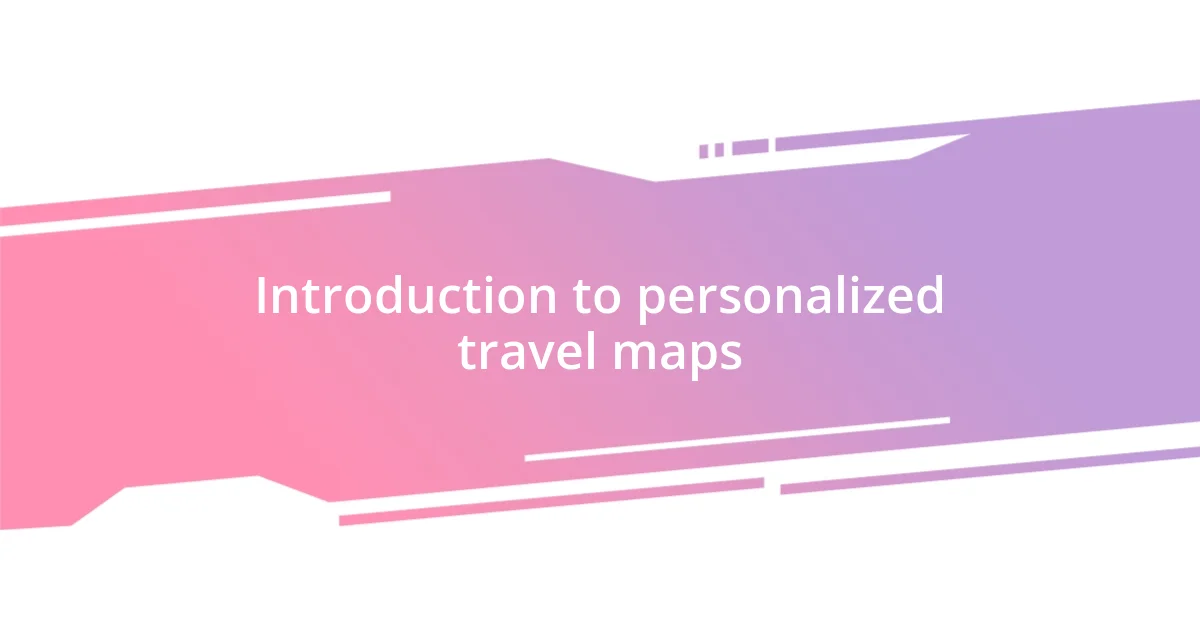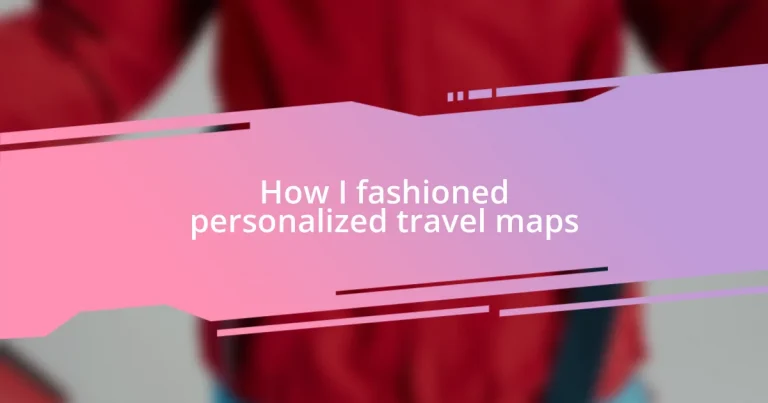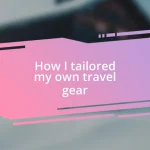Key takeaways:
- Personalized travel maps serve as emotional keepsakes, capturing unique experiences and stories from journeys.
- Tools like Google My Maps and Mapbox offer various customization options, enabling travelers to design maps that reflect their adventures.
- Incorporating symbols, timelines, and multimedia elements enhances the interactivity and depth of travel maps, turning them into living scrapbooks of experiences.

Introduction to personalized travel maps
Traveling is not just about the destinations; it’s about the stories we collect along the way. Personalized travel maps allow us to capture those unique experiences and memories in a way that feels truly our own. Have you ever wished to hold a physical representation of your journey, something more meaningful than just a standard map?
I remember creating a personalized map after my road trip across the coast. Each pin marked a special moment—a breathtaking sunset, a small café where I met a local artist, or that charming bookshop tucked away from the busy streets. Those little details transformed the map from a simple tool into a cherished keepsake, sparking joy every time I glance at it.
With technology at our fingertips, the process of crafting these maps has become both accessible and exciting. As I dive into the world of personalized travel mapping, I find myself asking: what moments do I want to encapsulate? Collecting my favorite experiences into one visually appealing, interactive map not only tells my story but also inspires others to embark on their adventures.

Importance of personalized travel maps
Personalized travel maps hold significant emotional value, serving as tangible reminders of our unique journeys. When I look back at my own map from a trip to Italy, it’s not just a representation of locations; it’s a reflection of feelings and connections made along the way. Each marked spot brings a flood of memories, from the laughter shared over gelato to the awe I felt standing before historical landmarks.
- They evoke nostalgia and deepen the emotional connection to the places visited.
- Customization allows for personal storytelling—every mark, a chapter in the travel narrative.
- They inspire others, sparking curiosity and the desire to explore.
- Creating one can be a therapeutic exercise, helping individuals relive their adventures and crystallize cherished memories.
In my experience, the act of personalizing a travel map not only adds a creative touch but also encourages me to reflect on what those moments truly meant. Each time I revisit the map, I’m reminded of the places I’ve been, the experiences that shaped me, and the dreams I still hold for future travels.

Tools for creating travel maps
When it comes to creating personalized travel maps, there are several fantastic tools available that cater to different styles and preferences. I’ve found that Google My Maps is an excellent starting point. It allows for easy pinning of locations, adding notes, and sharing with friends. I enjoyed using it during a cross-country trip, where I could plot my route and highlight quirky roadside attractions I discovered. It felt like curating my own highlight reel!
Alternatively, tools like Mapbox offer more advanced customization options. They inspire creativity by allowing you to design your own map styles and integrate them with apps. I remember diving into Mapbox for my last overseas adventure; the freedom to make the map visually aligned with my journey’s theme—using colors and icons that reflected the natural beauty I encountered—was both fulfilling and exciting.
Lastly, creating hand-drawn maps with tools like Canva or even traditional materials can completely transform the experience. I vividly recall sketching a map of my favorite hiking trails, detailing not only the pathways but also the breathtaking views and the little cafes along the route. Each brushstroke captured the essence of that journey, making it a lovely piece of art I now proudly display.
| Tool | Features |
|---|---|
| Google My Maps | Easy pinning and note addition, shareable with friends. |
| Mapbox | Advanced customization, allowing personalized map styles. |
| Hand-drawn/Canva | Creative expression, personal artwork representation. |

Design tips for travel maps
When designing travel maps, think about the visual story you want to tell. I often choose a color palette that resonates with the essence of my journey. For instance, during my last trip to the coastal towns of Oregon, I selected shades of blue and green, reflecting the ocean and forests. It’s fascinating how colors can evoke memories; every glance at a specific hue transports me back to the salty air and serene landscapes.
I also find that layering details enhances the narrative. Whether it’s adding handwritten notes about the best coffee shops or marking special moments with symbols, these personal touches make the map uniquely mine. Once, I included little stars for nights spent under the stars while camping. Each star now reminds me of the warmth of the campfire and the stories shared. Isn’t it incredible how a simple mark on a map can encapsulate so much emotion?
Finally, don’t shy away from including personal photographs or drawings. I remember sketching a tiny version of the Eiffel Tower on my Paris map, a nod to an unforgettable day spent walking along the Seine. It transformed the map from just a geographical representation to a canvas of experiences. This kind of personalization makes the map not just useful but a cherished piece of art. In what ways do you think your travels could be reflected through an artistic approach?

Sharing and using travel maps
Sharing travel maps can turn a solitary experience into a communal one. I love it when friends and family ask to see the maps I’ve created; it feels like I’m sharing a piece of my journey with them. Last summer, I sent my travel map of New England to a group of friends planning a similar trip. The excitement in their replies made it clear how inspiring a personalized map can be for someone else’s adventure.
Using these maps practically enriches the travel experience. I often reference my maps when reminiscing about trips, and they serve as a visual diary of sorts. Just last week, I revisited my map from a road trip through the Southwest, each pin a memory. It sparked conversations about favorite spots, like that quirky diner in Arizona where I had the best blueberry pancakes. Hasn’t a map ever made you feel like you were back on a memorable path, reliving those moments as if you were there again?
What I find most delightful is how these maps often evolve after sharing them. Friends might suggest new places to explore or ask for personalized tips. After sharing my Paris map, a friend mentioned a hidden gem that I’m now adding to my next trip! The collaborative aspect brings fresh perspectives and unexpected discoveries into the mix, turning your travel plans into a community-focused experience. How do you feel about involving others in your exploration through shared maps?

Enhancing maps with additional features
One effective way to enhance travel maps is by incorporating unique symbols that symbolize experiences or sentiments. For instance, when I traveled to Italy, I used a little pasta icon to mark every restaurant with a dish that stole my heart. Those symbols have a way of turning a simple navigation tool into a delightful treasure hunt, isn’t it exciting to discover culinary gems hidden in a map’s artful landscape?
Another feature that I find adds depth to my maps is the inclusion of timelines or trip milestones. Last summer, I created a timeline on my map detailing the days I spent in each city during my European adventure. I can vividly recall the thrill of each moment, like the day I got lost in a quaint village in Spain. Reflecting on my journey through this timeline not only anchors my memories but also transforms the map into a roadmap of emotion and experience—how does documenting your travels influence your recollection of those moments?
Additionally, integrating multimedia elements like QR codes can significantly elevate the map’s interactivity. On my recent trip to Japan, I added codes that linked to short videos and photos taken at specific locations. Whenever I scan those codes, I’m instantly transported back to that moment—like standing by the cherry blossoms in full bloom. It’s as if each map is not just a static image, but a living scrapbook of my adventures. Don’t you think that blending technology with traditional mapping adds a whole new layer to travel storytelling?














